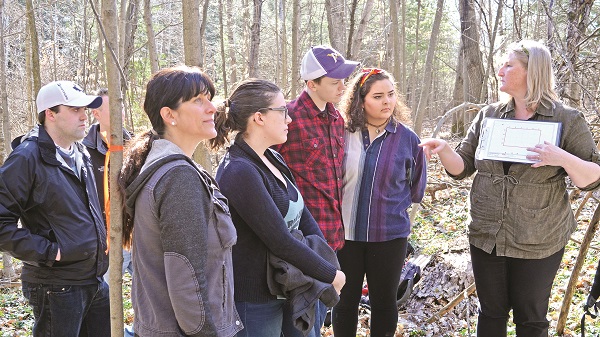This page was exported from The Auroran
[
http://www.newspapers-online.com/auroran
]
Export date: Sat Jul 27 0:41:53 2024 / +0000 GMT
"Amateur curators" chart unexplored part of Aurora’s past

By Brock Weir
Portions of it have lain undisturbed for over 40 years, while other portions have lain forgotten for much longer.
For some Aurorans, it is a place in distant memory, a place of poignant but increasingly distant memories, its precise location lost to the sands of time.
For others, however, it is an area of untapped importance with enough potential to be worth a look as a potential national historic site.
The picture is much clearer now after scores of “amateur curators” trekked out into a non-descript place in the woods near Aurora's southwest corner to do a complete inventory of Aurora's Pet Cemetery.
Well, as complete as Mother Nature allows.
Led by Shawna White, curator of the Aurora Museum and Archives, and members of the Town of Aurora's planning staff, over a dozen amateur sleuths left Town Hall for the site before 9 a.m. to uncover the grave markers – some simple, some hugely elaborate – of beloved family dogs, cats, rabbits, and even an R.C.M.P. horse or two.
They were covered in growth, camouflaged in moss, toppled by shifting soil, and eroded by the elements, but that didn't matter.
There was an energy in the air and it was all about the thrill of the chase.
“It is an unfamiliar place in Aurora that a lot of people don't know about, so to actually get the opportunity to experience it and actually go through and look at the tomb stones of all these animals that came from locally and Canada-wide is pretty cool – and to be the first ones in many years to experience it,” said Laura Beeton, who was working a 10m by 10m plot of the pet cemetery with Malcolm Macchiusi, Nancy Black, and July Saavedra. “As a community, this was a really important place and it is interesting to see.”
While Malcolm and July – both horror fans – thought there was something particularly cool about exploring a pet cemetery, particularly if the weather was dark and drizzly, they were overcome by the sense of history in the warm light of day.
“The history here is incredible, and we're the first ones in who knows how long to uncover this,” said Malcolm.
The enthusiasm of the “amateur curators” brought a tear to the eye of local historian David Heard, who has been a long-time proponent of getting national recognition for this pet cemetery which could be one of the oldest, if not the oldest, in Canada.
Surrounded by land slated for development, the land on which the pet cemetery is situated was deeded back to the Town and they hope to have a trail connection for people to come and take it all in by 2018.
“This is the future moving forward,” said Mr. Heard. “This is what it is going to take for this to become what its potential is as a tourist destination is moving forward, and with national designation. It is going to take a lot of upkeep to keep it beautiful, but respected. I am blown away by this turnout. My heart is welling up just talking about this.”
Ms. White joined the curators, amateur and otherwise, in the fray.
When she first became involved with the Aurora Museum and Archives, her interest was instantly piqued when she heard about the pet cemetery's existence, particularly with her archaeology background.
“A museum and archives is more than just four walls, it is the entire community, the resources we have in the community, and the stories we have in the community,” she says. “This is an important story for the community, for the broader community, and people across Canada who actually sent their pets here. Everyone has a connection to their pets, and some have more of a connection to their pets than to their family, so this shows a real level of love and care. But, in order to properly document it, you have to know what you have.”
For Mr. Heard, it is all about the history, but it also comes with a relevant message to people across the board.
“I think sometimes we treat our pets better than we do our family members, our friends and neighbours,” he said. “This is what we need to do to respect them. If we put this much effort into people with two legs, we would have a better world – but this community involvement is a start of that. We're moving in the right direction. To see the camaraderie of the people who are working here, working together as teams, that is what we need moving forward with this site. It is going to take a team. To see Councillors working alongside the Heritage Advisory Committee, alongside volunteers, and every one of them is named an amateur curator today is awesome.”
Excerpt: Portions of it have lain undisturbed for over 40 years, while other portions have lain forgotten for much longer. For some Aurorans, it is a place in distant memory, a place of poignant but increasingly distant memories, its precise location lost to the sands of time.
Post date: 2016-04-20 21:11:07
Post date GMT: 2016-04-21 01:11:07
Post modified date: 2016-04-20 21:11:07
Post modified date GMT: 2016-04-21 01:11:07
Powered by [ Universal Post Manager ] plugin. MS Word saving format developed by gVectors Team www.gVectors.com